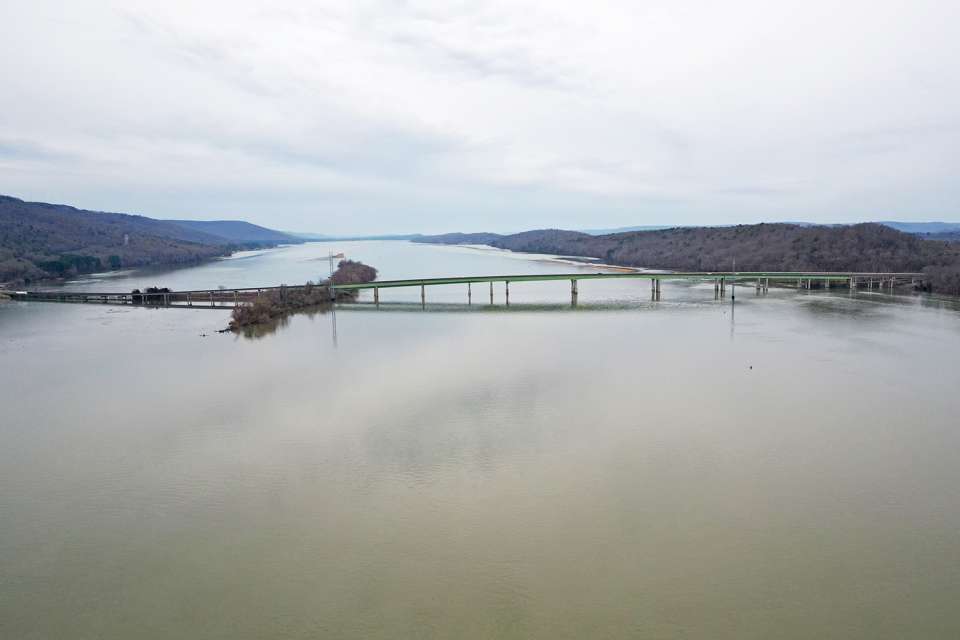
Drew Cook’s a nice enough guy, but come tournament time, he doesn’t like company — particularly on lakes where company grows thick. That’s why spectators and media boats patrolling Lake Guntersville’s perennial favorites like Brown’s Creek, Spring Creek, Town Creek, Seibold, Goose Pond, etc., often have a hard time finding the 2019 Elite Rookie of the Year.
Fact is, the Florida pro has strongly favored upriver spots ever since he and his team trail partner first laid eyes on Guntersville a handful of years ago. Thorough recon included an upstream visit, and Cook said it was love at first site.
“We put in down the lake, and we wanted to look at everything,” he said. “We ran all the way up there and once we got within sight of the B.B. Comer Bridge, it looked right. That’s where we focused a lot of our time, and we ended up winning two Reel Money championships (2016, 2017) up there.”
In this year’s Classic, Cook fished Guntersville’s upper third after the week’s big winds blew out some of his upriver stuff. That’s the risk you take when making a long run, but the potential goldmine is worth the effort.

Dependable positioning
While Cook clarifies that he does not consider himself a “river rat” per se, he does have a lake-specific inclination. The twofold attraction is less congestion and more favorable dynamics.
“When it comes to Guntersville, I do tend to lean toward that river a lot more, because Guntersville is the most pressured lake (in the U.S.),” he said. “There are boats on it all the time and that whole section — Seibold, Brown’s, Spring — it gets pounded; whereas, up that river, it gets overlooked.
“Also, the grass sets up so much better there for the way I grew up fishing the Flint River around Lake Seminole. It’s a lot more current-oriented up there because everything is necked-down. Once you get around Rosebury Creek, it really starts becoming more of a river than a lake.”
As Cook explains, narrowing the flow increases current velocity, and with all that swift water, the fish are seeking slack water sanctuaries.
“With the grass beds that are on the river channel and every little point, they set up a lot better; whereas, if they didn’t have any current and everything was a lot lighter, they may not be set up as dependably,” he said. “The same amount of current coming out of that river is flowing into the lake, but as Guntersville gets wider and wider, all that current gets distributed throughout the whole lake.
“If your boat’s floating at 3 mph upriver, above B.B. Comer Bridge, whenever you get down there around Seibold, you may be moving only 1/2 mph. They tend to group up better when there’s current like that.”
Cook’s targets
Cook described his ideal upriver Guntersville scenario as anywhere the current makes the most profound impact.
“I like an outside bend on the down-current side where the most current runs into the grass or the bank,” he said. “For summertime river fishing, that’s the key. You can take that to almost every river in the country and do well.
“It makes perfect sense, when you think about it. If you threw something into the water and it got washed away with the current, where’s the first place it’s going to hit something and stop? I’m looking for places where the fish can sit behind something and let the river feed them.”

Grass will almost always be his top preference, but absent the vegetation, the river’s accumulation of logs and laydowns offer tempting targets.
Cook’s baits
Tactics vary based on cover and seasonality, of course, but Cook said his strong preference is flipping. Give him a Big Bite Baits Yo Mama escorted by a big weight and he’s a happy camper.
“Twelve months of the year, you can flip up there,” he said.
He’s also keen to throwing swimbaits, lipless baits, squarebills like the Spro Fat Papa and spinnerbaits. For the latter, Cook likes a 1/2-ounce double willow (gold/silver) bait with a chartreuse/white skirt. This setup does the job, but he keeps a couple of options handy to best fit the day’s deliverance.
“That’s as old as bass fishing, but a spinnerbait still catches them,” Cook said. “I don’t think you need to get super specific with a spinnerbait. I think the blades do most of the work.”
“If I’m fishing in an area without a lot of wood, I’ll put a Big Bite Baits 2.8 Pro Swimmer and a trailer hook on there,” he said. “A lot of times, if I’m getting tight up in the cover and throwing underneath overhanging branches, I won’t put a trailer hook on there because it will end up costing you too much time.
“Also, if you feel like you need to be throwing a spinnerbait, you don’t need a trailer hook; they’re going to eat it. If they don’t, you might want to throw a bladed jig or a crankbait.”
Convinced
So, does Cook believe his preferred upriver haunts hold the juice? Can you win a major event — even a Classic — in that necked-down current?
“Hundred percent,” Cook said. “It definitely does hold enough fish to win a big tournament. On Day 2 of the Classic, I lost a 9-pounder and a 7-pounder. Both bit a Spro Aruku Shad (lipless bait). I saw both of those fish; I was reaching down to grab them when they got off. They just weren’t eating the bait well.”
Summarizing his motivation to keep running upriver in Guntersville tournaments, Cook makes this key point: It’s all about the probability.
“On Guntersville, the population of fish up there is not what it is down lake, but the lighter fishing pressure is what makes it easier. You have fewer fish upriver, but two thirds of them will bite vs. maybe one third down the lake.”





